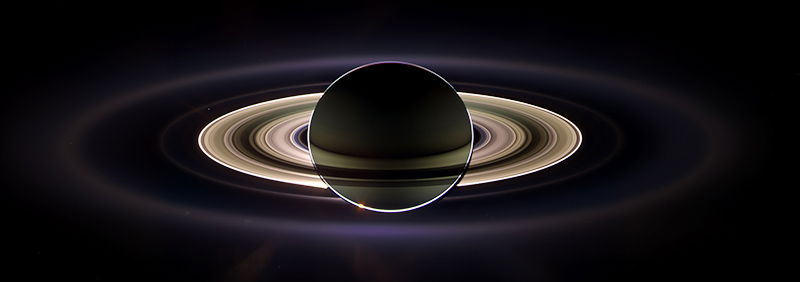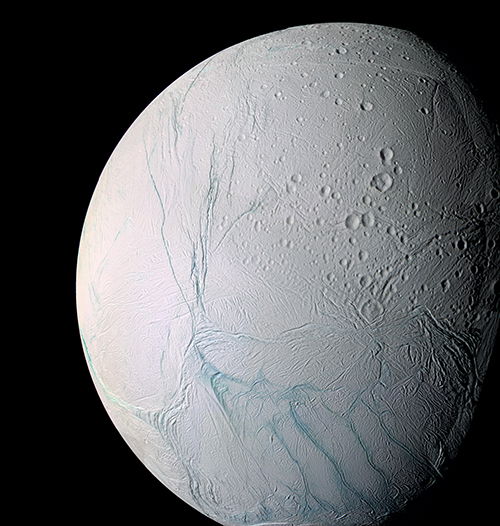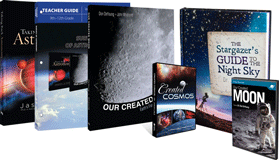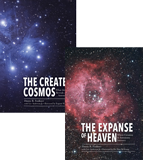
Saturn—Jewel in the Creator’s Showcase
The space probe Cassini’s most amazing discovery didn’t make the headlines: the clear testimony to Saturn’s young age and the fact that it had a Creator.
Fire!
On September 15, 2017, the Cassini spacecraft plunged into Saturn’s upper atmosphere, burning to a crisp. What happened? Bad programming on NASA’s part? No, it was a planned crash.
The $3.26 billion Cassini-Huygens mission, launched in 1997, was a resounding success. It vastly improved our understanding of Saturn, its satellites, and its exotic ring system. Cassini also carried the Huygens module, which landed on Titan, the largest of Saturn’s moons, on January 14, 2005. This marked the first landing on a moon besides earth’s moon, and Huygens sent back a wealth of data.
Near the end of its mission, Cassini completed a number of risky passes through the gaps between Saturn and its inner rings. Finally, as the spacecraft began to run out of fuel, engineers sent it barreling into Saturn’s atmosphere. Even in its last gasp, Cassini captured more newsworthy details that surprised secular scientists.
The most amazing surprises of all, however, didn’t make the headlines: the mission gave clear testimony to the young age of this glorious ringed planet and the fact that it had a Creator.
One-Of-A-Kind Planet
Ever since Galileo discovered Saturn’s rings (they looked like “ears” to him), the planet has intrigued humans. When the Creator finished Saturn on day four of creation week, surely he grinned in satisfaction.
Far from the sun, Saturn is strikingly different from earth. A giant planet made almost entirely of gas and liquid, Saturn is over 750 times the earth’s volume. While earth has the greatest density of any planet in our solar system, Saturn has the lowest. Earth is solid like the other inner planets (Mercury, Venus, and Mars), while Saturn is a gas planet like the other outer planets (Jupiter, Neptune, and Uranus), made up mostly of hydrogen and helium. In fact, its density is so low that if we could toss it into a giant bathtub, it would float!
To many of us, it’s strange to think that some planets aren’t solid. But the question that puzzles astronomers is why our solar system has both types of planets. It’s hard to explain if both evolved from the same spinning disk of gas and dust. Wouldn’t the same process produce similar planets?
Secular astronomers usually find one type of planet or the other around other stars. They offer suggestions for the unusual makeup of our solar system, but the explanations still have holes. A desire to fill those holes helps to explain Cassini and continuing missions to probe the planets.
Lord of the Rings
One of the most fascinating and surprising touches God gave Saturn is its bright rings, earning it the nickname Jewel of the Solar System. While other gas planets have rings, none are as spectacular as Saturn’s, and this prompted astronomers to think more deeply about how a planet could acquire these beautiful, mysterious (and unexpected) features.
In a small telescope, Saturn appears to have one solid ring. However, better telescopes have shown thousands of rings, nested closely together. And instead of being solid, the rings are composed of billions of particles of dust, rock, and ice, all orbiting the planet together. Some are as small as a grain of sand; others are as large as a building. The rings orbit at different speeds, yet they are so stable and unique that each ring and gap between the rings has its own name.
The relative thinness is astounding. If Saturn’s rings were as wide as San Francisco, they’d be paper thin. People on earth see the rings only because God gave the planet a tilted axis. What process could possibly produce—and maintain—these seemingly delicate features?
“Saturn’s rings are more than just belts of particles orbiting the planet,” says Spike Psarris, a former engineer in the NASA space program who has been watching the Cassini mission closely as a creationist. “There are spokes in the rings, like wheels. Some rings are even braided. Nobody expected these features in the rings. It’s as if somebody created them to delight and fascinate us.”
Evolutionists once speculated that the rings developed billions of years ago when an asteroid crashed into the planet or its moons, causing a circle of debris. But Cassini uncovered just how dynamic the rings are.
“The observed changes in Saturn’s rings during the Cassini mission showed that Saturn’s rings are far younger than the 4.5 billion years most planetary scientists think.”
“The observed changes in Saturn’s rings during the Cassini mission showed that Saturn’s rings are far younger than the 4.5 billion years most planetary scientists think,” observes Danny Faulkner, another creation astronomer (at Answers in Genesis) who has been following Cassini.
“To rectify this, they now suggest that Saturn’s rings resulted from the recent tidal disruption of a satellite. In other words, Saturn’s strong tidal forces must have torn apart one of its satellites.” However, since all four of the outer planets have rings, it is highly improbable that this happened recently to all of them.
During its final passes through the rings, Cassini measured their gravitational pull and confirmed they’re too light to have lasted billions of years. Furthermore, measurements of the dust coming from the outer solar system show that the icy rings are too clean to be billions of years old.
“There’s not much you can do about it. It has to be young,” concludes Sascha Kempf, a space physicist, in a Science report. “I’m back to square one,” admits planetary scientist Larry Esposito, who acknowledges that the existence of Saturn’s rings seems “lucky.”

NASA/JPL/Space Science Institute
With Saturn blocking the sun’s glare, Cassini viewed the rings from a new perspective—looking back toward earth—and revealed previously unknown faint rings.
A Spry Young Planet
Cassini also gathered data about Saturn’s core and gravitational forces to resolve a nagging question: how could it have such a powerful magnetic field, since magnetic fields lose energy over time? Evolutionists hypothesized that Saturn’s magnetic field is maintained by something inside called a dynamo (sort of like a chemical imbalance in a battery).
But the direction of the magnetic field showed Saturn doesn’t have a dynamo. This means the planet can’t be billions of years old. In fact, all the outer planets are more dynamic or give off more heat than is possible in an ancient, run-down solar system.
A Sea of Inexplicably Amazing Moons
Earth has just one moon. Saturn has at least 62, including dozens of moonlets. The astonishing variety defies a simple explanation apart from the handiwork of a Creator who loves beauty and variety.
Two Dancers
For instance, Cassini observed firsthand how two of these tiny moons, Epimetheus and Janus, “dance.” The paths of their orbits around Saturn are so close that for years planetary scientists thought just one moon was there. Every four years, one catches up with the other and they trade places. One gains momentum and speeds farther out from Saturn, while the other loses the same amount of momentum and falls inward in a celestial ballet.
Is there any rhyme or reason for dancing moons? No—except perhaps to remind us of our Creator’s creativity!
Earthlike Titan
Earthlings were especially interested in studying Saturn’s largest moon, Titan, because its atmosphere and surface are so similar to earth’s. Larger than the earth’s moon, it’s the only moon known to have an atmosphere. Evolutionary astronomers hoped to better understand how the atmosphere evolved.
Titan’s atmosphere is more like the earth’s than any other body in the solar system, yet there are still vast differences. Titan lacks free oxygen (unbound to other elements), while the earth’s atmosphere is 21% oxygen. And Titan’s surface temperature is a little colder, a chilly –290°F.
The Huygens module showed that Titan’s atmosphere is much more dynamic than they expected at these low temperatures. Liquid methane (natural gas) and other organics occasionally rain down on its surface like water on earth. Moreover, rocks and pebbles, possibly made primarily of water ice, dot the surface.
Even more helpful than Huygens’ transmissions after landing, which lasted a mere 90 minutes, was the Cassini probe. Its infrared instruments and radar pierced Titan’s opaque atmosphere and sent back a stream of helpful information about this dynamic world. “For example, it found what appear to be lakes of liquid methane on the surface,” explains Faulkner. “There also appeared to be volcanic features. Being so cold, the ‘molten material’ almost certainly is liquid water rather than rock, as on earth.”
Evolutionists were not looking for lakes, however. They expected whole oceans full of liquid methane. Why? Well, it gets a little complicated. Astronomers had long suspected that Titan has methane in its atmosphere (and Cassini confirmed this). The challenge is that sunlight breaks down methane into ethane and other chemicals. So after just 10 million years, the atmosphere’s methane should all be gone. If Titan is 4.5 billion years old, where is all that methane coming from?
Evolutionary astronomers hoped to find oceans of it, along with oceans of ethane, which should be produced by the breakdown of all that methane over billions of years. Instead, they found that the moon’s surface is dry, except for some lakes that may be ethane and methane and certainly aren’t enough to support an old-Titan theory.
“Titan might be just a moon, but it’s a great demonstration of the failure of evolutionary theory,” observes Psarris.
Secular scientists were also quite confident that Titan would be covered with thousands of craters after billions of years of asteroid hits. Surprisingly, the photos of the Cassini-Huygens exploration showed only 60 craters on 50 percent of Titan’s surface. That’s also great news for creationists. “The sparseness of craters and their freshness strongly suggest that Titan’s surface is far younger than its supposed 4.5-billion-year age,” Faulkner concludes.
Energetic Enceladus
Cassini revealed more surprises on another of Saturn’s moons, Enceladus. Photos showed a huge geyser exploding on the south pole. “According to evolution, Enceladus is supposed to be billions of years old. It’s supposed to have cooled off from its formation eons ago; it’s not supposed to have the energy to do any of this,” explains Psarris.
Furthermore, the moons close to Enceladus are much brighter than expected. “Apparently Enceladus is spray-painting them with ice and snow. Evolutionary models say that Enceladus is old, cold, and dead, but it’s not any of those things,” he says. “Enceladus is a great piece of evidence for a young solar system—even one that is just a few thousand years old.”

NASA/JPL/Space Science Institute
Enceladus appears to be spray-painting neighboring moons with ice—something an old, cold world could not do.
New News is Old News
The new news about Saturn is, in a sense, old news to creation astronomers. The Cassini-Huygens mission has helped to debunk the assumption that the solar system evolved by chance after chance (and asteroid hit after asteroid hit) over billions of years. Instead, the information confirms the handiwork of a Creator only a few thousand years ago.
We already know that because the Creator documented his own eyewitness account in Genesis 1. On day four, he made all the heavenly bodies.
Missions like Cassini-Huygens are still invaluable, as they help us piece together the details of our God’s handiwork. “The Cassini-Huygens findings show the diversity that we find in a created world, something that people generally didn’t expect,” Faulkner says. “Furthermore, for the recent creationist, they offer exciting evidence of recent origin.”
Saturn gives us yet another reason to rejoice over the truth of Psalm 19:1, “The heavens declare the glory of God, and the sky above proclaims his handiwork.”
Faulkner adds that despite these
findings, evolutionary scientists will
continue to explain them away as
anomalies. But for those of us who
believe God’s Word, Saturn gives us
yet another reason to rejoice over
the truth of Psalm 19:1,
“The heavens
declare the glory of God, and the sky
above proclaims his handiwork.
”
“Saturn tells us not only that our Creator is skilled, majestic, and powerful, but also that he appreciates beauty,” Psarris points out.
Psalm 136:3–5 admonishes us not
only to recognize God’s handiwork but
to “give thanks to the Lord of lords . . .
who alone does great wonders, . . . who
by understanding made the heavens,
for his steadfast love endures forever.
”
If God devoted such amazing attention to the details of creating the heavenly bodies, how much more attention did he pay to creating humans in his image! The one who hung Saturn in the sky also gave his Son so we could not only enjoy his work, but live forever in a relationship with him.
Answers Magazine
March–April 2018
The beach beckons us with its seashells. More than just ornate collectables, they testify to the Creator’s lavish provision for even the lowliest creatures. The Creator designed shells with mind-boggling features evolution can’t begin to explain.
Browse Issue SubscribeRecommended Resources

Answers in Genesis is an apologetics ministry, dedicated to helping Christians defend their faith and proclaim the good news of Jesus Christ.
- Customer Service 800.778.3390
- © 2024 Answers in Genesis






